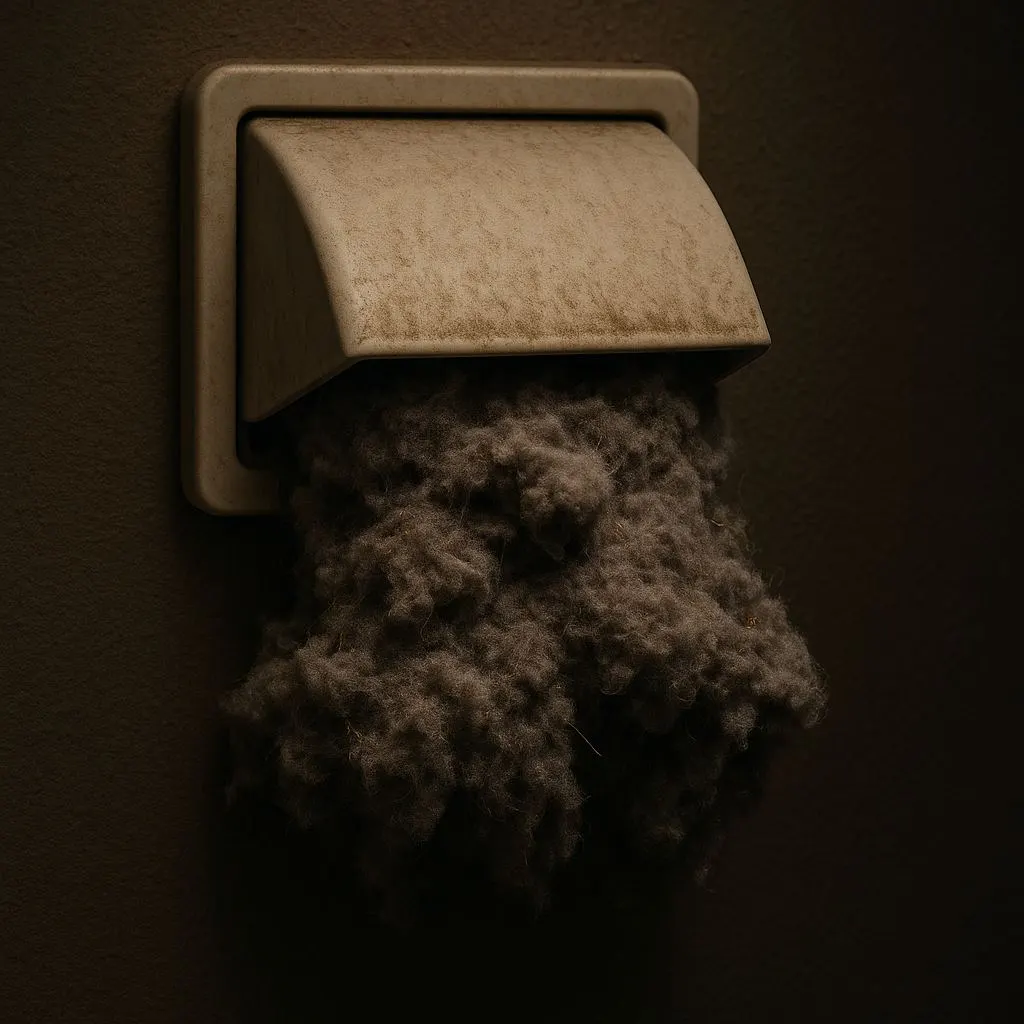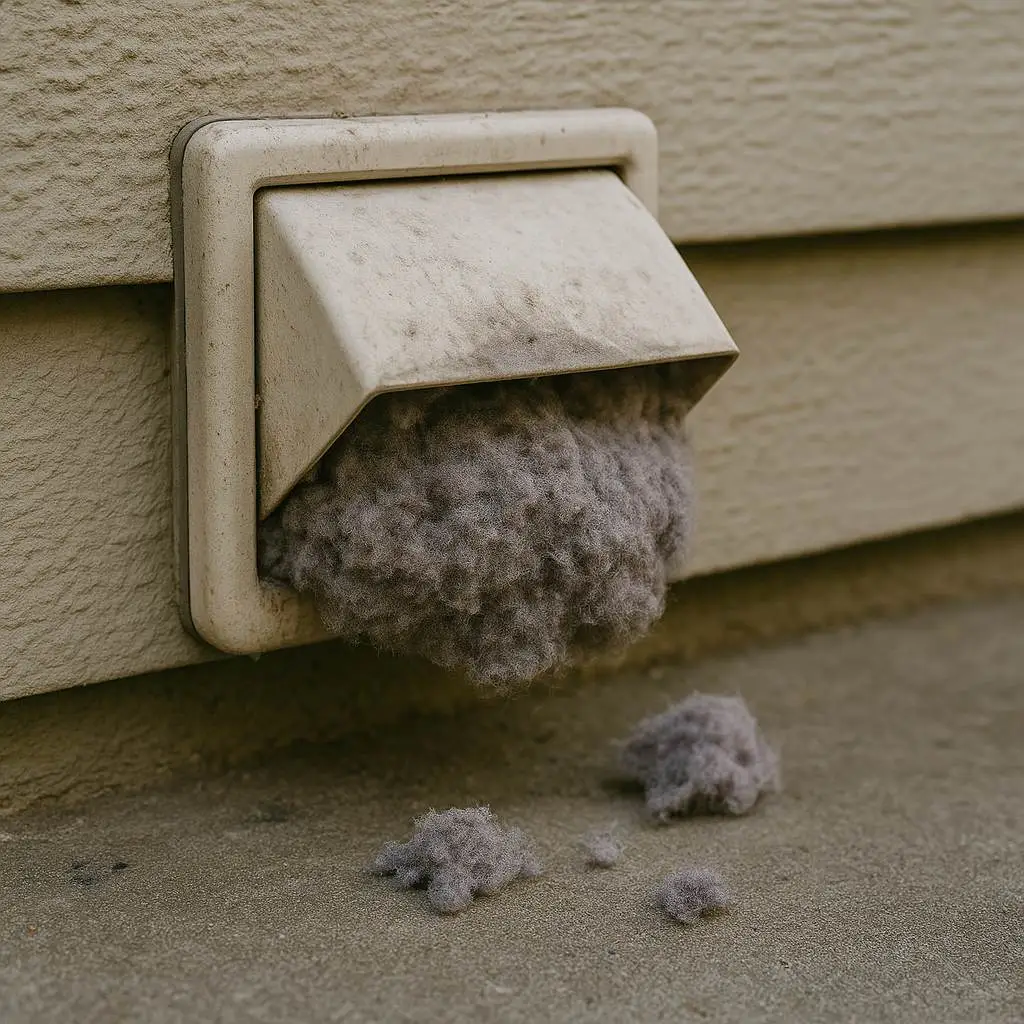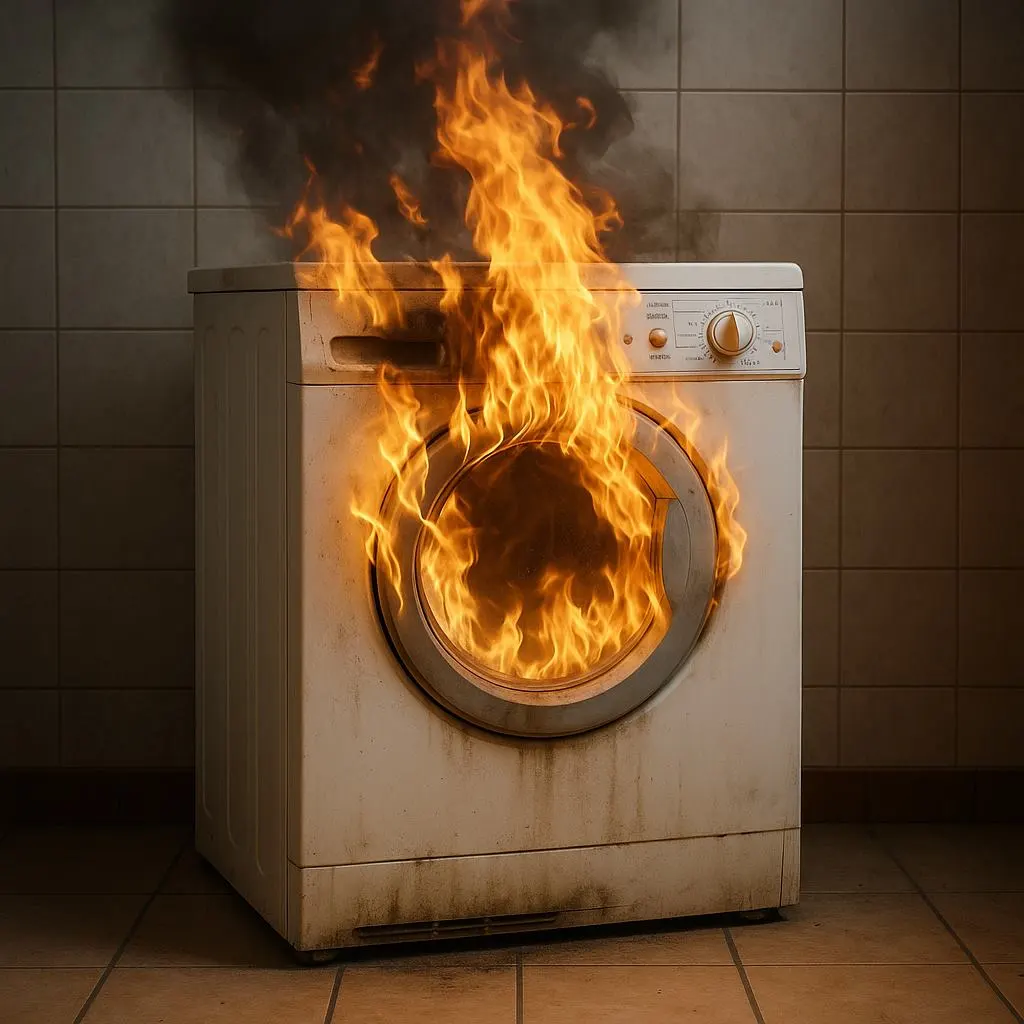Top 5 Blocked Dryer Vent Warning Signs
You toss a fresh load of laundry into the dryer. It hums softly in the background as you return to your routine maybe dinner prep or winding down on the couch. Everything seems normal… until it’s not. Hours later, your clothes are still damp. The room is hotter than usual. Then you notice it: a faint burning odor. It’s easy to shrug it off as a “weird appliance thing,” but what if it’s not?
What you may not realize is that your dryer vent could be dangerously clogged silently turning a common household convenience into a potential fire hazard. Dryer vent blockages are one of the most overlooked causes of appliance failure and household fires. But the good news is this: if you know what to look for, you can catch the signs early and save yourself thousands in repairs or a total disaster.
In this guide, you’ll discover the top 5 warning signs of a blocked dryer vent, why they matter, and exactly what you can do to protect your home, your investment, and most importantly, your loved ones.

Why Blocked Dryer Vents Are a Serious Hazard
Dryer vents are out of sight and often out of mind—but the threat they pose is very real. According to fire safety data, thousands of home fires each year are traced back to dryer vent blockages. These fires are not only destructive but often entirely preventable with proper maintenance and timely detection of red flags.
Here’s why this issue deserves your full attention:
Clogged vents trap hot air, causing your dryer to overheat.
Lint buildup is highly flammable and can ignite under prolonged exposure to heat.
Blockages make your appliance work harder, increasing wear and spiking your energy bills.
Most modern dryers are designed to shut off during emergencies, but by the time they do—it may already be too late.
The key to safety is prevention. That starts with awareness.
 Warning Sign #1 – Your Clothes Take Too Long to Dry
Warning Sign #1 – Your Clothes Take Too Long to Dry
Your First Red Flag: Time
One of the earliest indicators of a blocked dryer vent is when your clothes take much longer than usual to dry. You may find yourself running multiple cycles just to get a single load completely dry. While it’s easy to assume that your dryer is just aging or losing efficiency, the real culprit is often the vent itself.
Why It Happens
The issue typically stems from lint buildup within the vent. Even if you regularly clean the lint trap, that’s just the start. Over time, small particles bypass the screen and make their way into the vent duct, slowly accumulating and forming a dense, airflow-blocking mass.
Here’s why a blocked dryer vent makes drying take forever:
Reduced airflow: As lint accumulates, the path for moist, hot air becomes restricted, keeping your clothes damp.
Trapped moisture: With nowhere to go, the moist air stays inside the dryer, preventing efficient drying.
Increased workload: Your dryer has to work much harder to push air through a blocked dryer vent, leading to longer cycles and higher energy bills.
 What You’ll Notice
What You’ll Notice
It’s not always obvious that a blocked dryer vent is the issue, but these tell-tale signs should raise a red flag:
Damp or warm clothes even after a full drying cycle.
Multiple drying cycles needed to fully dry one load of laundry.
Hot or humid laundry room after running the dryer.
A burning smell or unusual heat coming from the dryer unit.
It’s easy to dismiss these symptoms as a sign of an aging appliance, but more often than not, they indicate that your dryer vent needs attention.
 What You Should Do
What You Should Do
If you’ve noticed these signs, it’s time to take action. Ignoring the problem could lead to more than just inconvenience—it’s also a fire risk. Here’s how to tackle the issue:
Stop overloading your dryer: Excessive loads mean more lint and a greater chance of clogging the vent.
Clean the lint trap: While this doesn’t solve a blocked dryer vent issue on its own, it’s still a crucial first step.
Schedule a professional inspection: A certified technician can assess the vent for blockages and use specialized tools to clear out compacted lint.
Don’t Assume It’s Just Your Dryer Getting Old
Many homeowners mistakenly believe that their dryer’s age is to blame when clothes take too long to dry. The reality? It’s often the vent system causing the trouble. By addressing the blocked dryer vent early on, you not only improve drying efficiency but also reduce fire hazards and extend the lifespan of your appliance.
For reliable and thorough vent cleaning, reach out to AirDuctVet. We’ll ensure your dryer operates safely and efficiently, saving you time, money, and stress.
 Warning Sign #2 – You Smell a Burning Odor While the Dryer Runs
Warning Sign #2 – You Smell a Burning Odor While the Dryer Runs
Trust Your Nose: It’s Trying to Warn You
Nothing sets off alarm bells quite like the smell of something burning. When your dryer is running, the last thing you want to detect is a warm, smoky, or scorched odor coming from your laundry room. If this happens, it’s more than just a strange smell—it’s a red alert. A blocked dryer vent could be the hidden culprit, and ignoring it could put your home at serious risk.
 What It Means
What It Means
A burning smell during a drying cycle is not something you should ever overlook. This odor is often a sign that lint or debris trapped within a blocked dryer vent is overheating. Here’s why that smell is more dangerous than you might think:
Lint ignition: Lint trapped inside your dryer vent can reach dangerously high temperatures. Since lint is highly flammable, it only takes a small spark or prolonged heat to ignite.
Overheating components: When airflow is restricted due to a blocked dryer vent, your dryer’s internal parts, including the heating element, may overheat. This puts extra stress on the motor and other components.
Potential combustion: In extreme cases, the heat buildup can cause small, undetected fires within the vent duct itself, smoldering before breaking out.
When you notice a burning odor, it’s your dryer warning you of an imminent hazard. This is a situation where hesitation can be catastrophic.
 Common Mistake: Ignoring the Smell
Common Mistake: Ignoring the Smell
It’s easy to dismiss the odor as just “hot laundry” or the normal scent of freshly dried clothes. Unfortunately, this assumption can be dangerous. Many homeowners make the mistake of waiting until the dryer stops working entirely before addressing the issue, thinking it’s a minor problem rather than a critical blocked dryer vent situation.
However, once the smell appears, it’s often an indication that lint buildup has reached a hazardous level. Waiting to take action means putting your home at risk of a dryer fire.
 Immediate Actions You Should Take
Immediate Actions You Should Take
Don’t let that burning smell become a catastrophe. Here’s what you need to do the moment you detect it:
Stop using the dryer immediately: Turn it off as soon as you notice the odor.
Unplug the appliance: Disconnecting power reduces the risk of any electrical issues escalating the problem.
Inspect the lint trap: Remove and clean it, but remember—this is only a temporary fix.
Call a professional dryer vent cleaning service: This is not a DIY situation. A certified technician will thoroughly inspect your blocked dryer vent and clean it safely and efficiently.
 This Isn’t a Wait-and-See Situation Act Quickly
This Isn’t a Wait-and-See Situation Act Quickly
A burning smell from your dryer is more than just an inconvenience—it’s a direct warning of a potential fire hazard. When dealing with a blocked dryer vent, acting fast is essential to protect your home and family. Professional cleaning services can remove dangerous lint buildup, restore safe airflow, and give you peace of mind.
For immediate assistance and expert dryer vent cleaning, contact AirDuctVet. Our trained technicians will thoroughly inspect and clean your vents, eliminating fire risks and ensuring your dryer operates safely. Don’t wait for a small issue to become a big disaster—reach out today.
Would you like a quick guide on how to maintain your dryer vents between professional cleanings?

 Warning Sign #3 – Your Dryer or Clothes Are Hot to the Touch
Warning Sign #3 – Your Dryer or Clothes Are Hot to the Touch
 Heat That Shouldn’t Be There
Heat That Shouldn’t Be There
Dryers are designed to produce heat to dry your clothes, but when your dryer or laundry comes out excessively hot, it’s a signal that something is seriously wrong. This is not just a minor inconvenience—it’s a critical warning that a blocked dryer vent could be causing your appliance to overheat.
Many homeowners mistakenly think that hotter clothes mean the dryer is just doing a better job. In reality, it’s a sign that hot air is trapped inside the system, unable to escape properly. Ignoring this can lead to serious damage and increased fire risks.
 What This Tells You
What This Tells You
If your dryer or clothes are unusually hot to the touch after a cycle, it’s often a clear indication of a blocked dryer vent. Here’s why that happens:
Trapped hot air: Instead of being vented outside, hot, moist air gets recirculated within the dryer, raising the internal temperature.
Overworked components: The motor, belt, and heating element are forced to operate at higher temperatures, leading to accelerated wear and potential breakdowns.
Poor airflow: The main function of the dryer vent is to expel hot air. When blocked, that heat has nowhere to go but back into the dryer and your laundry room.
This kind of trapped heat is not only inefficient but also potentially dangerous. An unchecked blocked dryer vent can easily escalate into a fire hazard if left unattended.
 What You Might Experience
What You Might Experience
Recognizing the signs of a blocked dryer vent is crucial to preventing damage and ensuring safety. Here’s what you might notice when your dryer is overheating:
Scorchingly hot clothes: Your garments come out extremely warm, even after a short drying cycle.
Hot dryer exterior: Touching the outside of your dryer feels warmer than usual, sometimes almost hot to the touch.
Warmer laundry room: You notice a significant increase in the temperature of the room where your dryer is located.
Humidity build-up: The room may also feel more humid or muggy than normal, as moist air fails to vent properly.
If you’ve experienced any of these symptoms, it’s essential to address the issue immediately. Don’t assume that hotter means better when it comes to drying performance.
 Consequences of Ignoring It
Consequences of Ignoring It
A blocked dryer vent doesn’t just make your dryer run hot—it causes a cascade of problems that can cost you time, money, and safety:
Permanent damage to your dryer: Constant overheating puts stress on vital components, leading to premature failure.
Higher energy bills: An overworked dryer consumes more electricity, driving up your utility costs.
Increased fire risk: Trapped heat, combined with accumulated lint, can spark a dangerous fire.
Ignoring this warning sign is risky. Replacing a burned-out dryer motor or dealing with fire damage is far more costly than preventive maintenance.
 Replace the Myth That Hotter Means Better
Replace the Myth That Hotter Means Better
Many people assume that hotter clothes are just a sign of an efficient dryer, but that’s not true when the heat is excessive. When it comes to dryers, overheating usually means that your venting system is compromised. Don’t fall into the trap of thinking your dryer is just “extra powerful.” The reality is that a blocked dryer vent is causing it to overheat, which can lead to both equipment failure and fire hazards.
The solution? Schedule a professional dryer vent inspection and cleaning with AirDuctVet. Our expert technicians will eliminate the blockage, restore safe airflow, and make sure your dryer is functioning efficiently and safely.

Would you like me to include a quick reference guide for common dryer vent issues?
 Warning Sign #4 – Lint Around the Dryer or Vent Opening
Warning Sign #4 – Lint Around the Dryer or Vent Opening
Seeing Lint Where You Shouldn’t? It’s a Sign.
One of the most overlooked warning signs of a blocked dryer vent is the appearance of lint in unexpected places. Typically, lint should only collect in the dryer’s lint trap. If you notice it accumulating around the appliance, on the floor, or near the vent opening, it’s not just a housekeeping issue—it’s a clear indicator of a problem within your venting system.
Lint escaping from the vent points to one critical issue: the vent is clogged, forcing the dryer to push out lint wherever it can. This can quickly escalate into a serious safety risk, including the potential for dryer fires.
 Where to Look for Lint Build-Up
Where to Look for Lint Build-Up
To catch the problem early, make a habit of inspecting these key areas around your dryer:
Behind the dryer: Dust bunnies mixed with lint often gather here if the vent is blocked.
Around the back vent hose: Check for lint that has escaped from loose or damaged connections.
At the exterior dryer vent cover: If you see lint piled around the vent flap or hanging from the opening, it’s a strong sign of a blocked dryer vent.
On the floor near the dryer: Even small amounts of lint accumulating on the ground can indicate a vent issue.
It might seem like just a little extra lint, but in reality, this buildup signals that your vent system is overwhelmed and no longer expelling debris properly.
 What It Means
What It Means
If lint is appearing in these places, it’s a red flag that your blocked dryer vent is causing airflow problems. Here’s why it happens:
Vent pressure is too high: Lint buildup inside the duct creates a blockage, causing pressure to push lint out through any available gaps.
Malfunctioning vent flap: If the exterior vent flap is stuck open or damaged, lint will blow out and accumulate around the opening.
Backfilling duct: In severe cases, the vent duct may be so full that lint starts backtracking into the dryer itself, leading to lint accumulation in and around the appliance.
Ignoring these signs can lead to more than just a messy laundry room—it can increase the risk of a dryer fire and reduce your dryer’s efficiency.
 Maintenance Tips to Prevent Lint Build-Up
Maintenance Tips to Prevent Lint Build-Up
Taking proactive steps can help you manage lint accumulation and reduce the chances of a blocked dryer vent. Here’s what you can do:
Monthly Cleaning: Move your dryer slightly away from the wall and wipe down the area behind it. Look for any signs of lint escaping the vent hose.
Inspect the Vent Flap: Go outside while your dryer is running and check that the exterior vent flap opens freely. If it’s stuck or jammed with lint, it needs immediate attention.
Full Duct Cleaning: Schedule a professional dryer vent cleaning at least once a year. A technician can remove lint from the entire duct length, reducing fire risks and improving efficiency.
Replace Damaged Parts: If you notice a cracked or warped vent hose, replace it promptly to maintain a secure, lint-proof connection.
 Visible Lint Means It’s Time to Act—Not Wait
Visible Lint Means It’s Time to Act—Not Wait
It’s easy to brush off a little lint around the dryer as a minor inconvenience, but in reality, it’s a sign of a blocked dryer vent that needs immediate attention. Don’t let the problem escalate—address it now to prevent safety hazards and extend your dryer’s lifespan.
If you’re seeing lint where it shouldn’t be, it’s time to call AirDuctVet. Our professional cleaning services will clear out built-up lint, fix venting issues, and ensure your dryer operates safely and efficiently.

Would you like a quick maintenance checklist to help keep your dryer vent in top condition?

Warning Sign #5 – Dryer Shuts Off Mid-Cycle
Emergency Shutdown = Emergency Problem
Your dryer is smarter than you think. Many modern models include safety shut-off systems designed to prevent overheating. But if yours keeps shutting off randomly—it’s trying to protect itself from a bigger issue.
What Happens:
The thermal fuse trips when the machine detects unsafe conditions.
This disables the heating element or the entire appliance.
Repeated shutdowns signal a serious airflow issue—typically a vent clog.
What You’ll Notice:
The dryer powers down before completing a cycle.
Clothes remain damp and wrinkled.
You keep restarting the machine to finish one load.
Important Reminder:
Replacing the thermal fuse won’t solve the core problem.
A blocked vent will trip it again and again.
Cleaning the vent restores safe operation and efficiency.
If your dryer seems moody or unpredictable, it might be screaming for help.
Final Thoughts – Don’t Let a Small Warning Become a Major Disaster
A blocked dryer vent might seem like a minor inconvenience, but the risks go far beyond longer drying times. Fires, appliance damage, rising bills—these are real consequences of ignoring early warning signs.
You don’t have to live with that risk.
By staying alert to the signs, performing regular checks, and calling in a professional when needed, you protect not just your machine—but your home and your family.
 Schedule Your Dryer Vent Cleaning Today
Schedule Your Dryer Vent Cleaning Today
You deserve peace of mind. You deserve safety. And with AirDuctVet, that’s exactly what you get.
Book your professional dryer vent cleaning today and eliminate the hidden fire hazard hiding in your laundry room.

